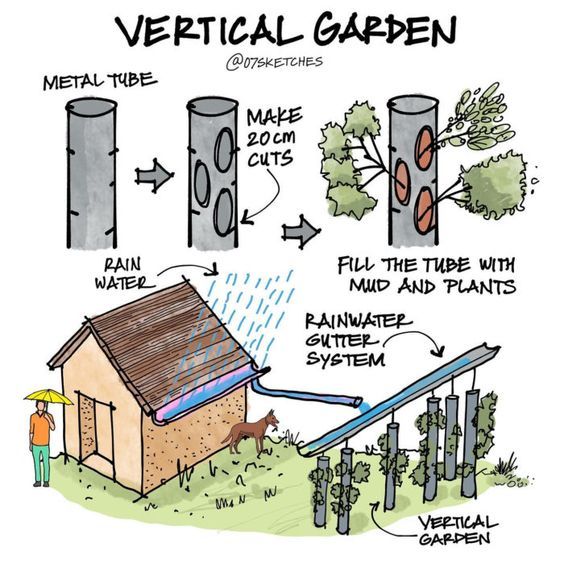From rooftops to small backyards, this simple design offers a sustainable solution for food security, water conservation, and urban beauty.
🌍 The Urban Challenge
Cities around the world are facing an environmental dilemma:
- Limited space for farming.
- Water scarcity due to climate change.
- Poor air quality caused by rapid urbanization.
As concrete jungles expand, the question becomes: Where do we grow food, and how do we do it sustainably?
This is where the Vertical Garden system, as illustrated above, enters the scene. It’s not just a creative gardening idea; it’s a blueprint for sustainable urban living.
🏗️ The Simple Yet Brilliant Design
The diagram shows a step-by-step method to create vertical gardens using metal tubes and rainwater systems:
- Metal Tube Preparation
- Start with a hollow metal tube.
- Make 20 cm cuts along its surface to create planting pockets.
- Planting Setup
- Fill the tube with mud and plants.
- Seedlings or herbs can be inserted into the cut openings.
- Rainwater Integration
- A rainwater gutter system channels runoff from rooftops.
- Water flows directly into the tubes, keeping plants hydrated.
- Vertical Growth
- Tubes stand upright, maximizing planting space.
- The result: a lush green vertical farm with minimal land use.
This clever use of gravity, water collection, and vertical orientation turns unused corners of homes into miniature eco-farms.
🌱 Environmental Benefits
Vertical gardens offer multiple eco-friendly advantages:
- Water Conservation 💧
By harvesting rainwater, the system reduces dependence on municipal supplies. - Urban Cooling 🌬️
Plants lower surrounding temperatures, reducing the urban heat island effect. - Air Purification 🍃
Vertical gardens absorb carbon dioxide and filter pollutants. - Soil Reduction 🌎
Instead of wide plots, tubes need only a small amount of soil, reducing pressure on land use.
This means that even densely populated neighborhoods can support agriculture.
🍅 Food Security in Small Spaces
One of the most powerful aspects of vertical gardens is their contribution to food security.
Imagine this:
- A family grows tomatoes, herbs, lettuce, or strawberries in just a few metal tubes.
- Entire communities could create shared vertical farms using rooftops or public spaces.
- Schools could teach children sustainable farming by using this hands-on system.
This method allows urban dwellers to produce fresh, organic food right at home, reducing reliance on supermarkets.
🏡 Social and Health Benefits
The impact goes far beyond food:
- Stress Relief 🌸
Gardening is proven to reduce anxiety and boost mental well-being. - Community Building 👨👩👧👦
Shared vertical gardens encourage collaboration in neighborhoods. - Educational Value 📚
Children learn about sustainability, water cycles, and plant biology. - Healthier Diets 🥗
Families eat more vegetables when they grow them themselves.
This transforms urban living into a more human, greener, and healthier experience.
🏙️ A Scalable Solution for Cities
While the diagram shows a small-scale backyard model, the idea can be scaled up:
- High-Rise Buildings 🌆
Vertical tubes on balconies or rooftops can turn skyscrapers into green towers. - Commercial Buildings 🏢
Offices can adopt vertical gardens to improve air quality for employees. - Urban Farms 🌾
Governments could set up large vertical farms in unused plots, powered by rainwater collection.
This could revolutionize how cities manage food production and water conservation.
🔧 The Engineering Behind It
At its core, the system combines three engineering principles:
- Gravity-fed irrigation – Rainwater naturally flows down into the vertical tubes.
- Hydraulic efficiency – Gutter systems minimize waste.
- Vertical load distribution – Tubes are sturdy and can handle soil weight without collapsing.
This shows how simple engineering can lead to powerful sustainable solutions.
🌎 Global Relevance
Different parts of the world can adapt vertical gardens to meet local needs:
- Asia – Dense cities like Singapore, Tokyo, or Mumbai could use vertical gardens to grow fresh herbs and greens on rooftops.
- Africa – In drought-prone areas, rainwater harvesting combined with vertical farming provides resilience.
- Europe & North America – Communities looking for sustainable lifestyles can adopt this system to reduce carbon footprints.
This proves that vertical gardening is not a luxury trend, but a necessity for future cities.
💡 Why It Matters Now
The world is facing:
- Rising food prices 🥦
- Water shortages 🚱
- Rapid climate change 🌍
Vertical gardens, as illustrated, address all three:
- Grow food cheaply.
- Use less water.
- Capture rainwater efficiently.
- Add greenery to fight climate impacts.
It’s a solution rooted in simplicity but capable of global transformation.
📰 Conclusion
The diagram beautifully demonstrates how a simple metal tube, some cuts, mud, and rainwater can reshape urban sustainability.
Vertical gardens aren’t just about saving space — they’re about saving the planet. They combine architecture, engineering, and nature to create a self-sustaining cycle of food and water use.
As the world moves toward greener cities, innovations like this will no longer be optional. They will be essential tools for survival, resilience, and healthier living.
🌱 The future of farming may not lie in wide-open fields but in vertical tubes standing proudly in our backyards, balconies, and rooftops.
